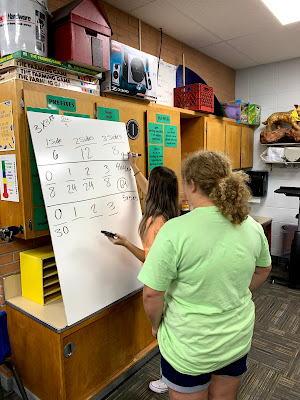We defronted the classroom. (Chapter 4)
We gave a non-curricular task. (Chapter 1)
And did all of our thinking on vertical whiteboards. (Chapter 3)
And it flowed.
Really well.
Not only was it day 1 of BTC (Building Thinking Classrooms)
But it was the first day of school!
I gathered the class around my "go-dium" cart.
I had 3-D models of the various sized cubes.
I explained the problem and directed their attention to the board where it was written out
Should they have questions after I sent them to their NPVSs.
Today's Task:
Picture a Rubik’s Cube. Now picture dropping it into paint so that it is completely covered. When the paint is dry, imagine breaking it apart into the smaller cubes. How many of the cubes have one face covered in paint? How many cubes have two faces covered in paint? How many have three faces covered in paint? How many have zero faces covered in paint?
How could you predict the above for any size Rubik’s cube?
What about a 4 x 4 x 4? 5 x 5 x 5? 6 x 6 x 6? N x N x N?
Thoughts:
For the most part,
I could already tell that more thinking was happening.
Maybe it was because it was the first day?
Maybe it was a please the teacher kind of thing?
Maybe they were actually intrigued with the problem?
Maybe they liked being able to think with others?
In one class, I noticed a lot of movement to the 3D figures.
Most of the conversation around this was on task.
However, movement created a blip in the bubble of thinking,
allowing space for other conversation to creep in.
In another class, only 70% of the class was in thinking mode.
It was my largest class.
The groups were fairly close together,
Allowing those not interested in participating to congregate together a bit.
Will need to figure out how to engage all 100%!
At the end of class, as a whole group, we talked about the benefits of using the others' boards.
I can only be in one place at one time.
If a group has a question,
It doesn't make sense to stop working until I can get to them.
By using the boards, groups can gain information on where to go after solving a problem,
Get unstuck if they are struggling,
And check their answers.
This was foreshadowing to mobilizing knowledge. (Chapter 8)
We talked about the difference of just copying answers
or figuring out who has the right answer if an answer doesn't match another group's board.
Day 1 Summary:
1. Lots of expectations woven into real life application.
2. Math thinking on the first day of school!
3. Non-intended intro to the concept of cubes.
4. Value of seeing the problem...drawing pictures...using our fingers...




No comments:
Post a Comment